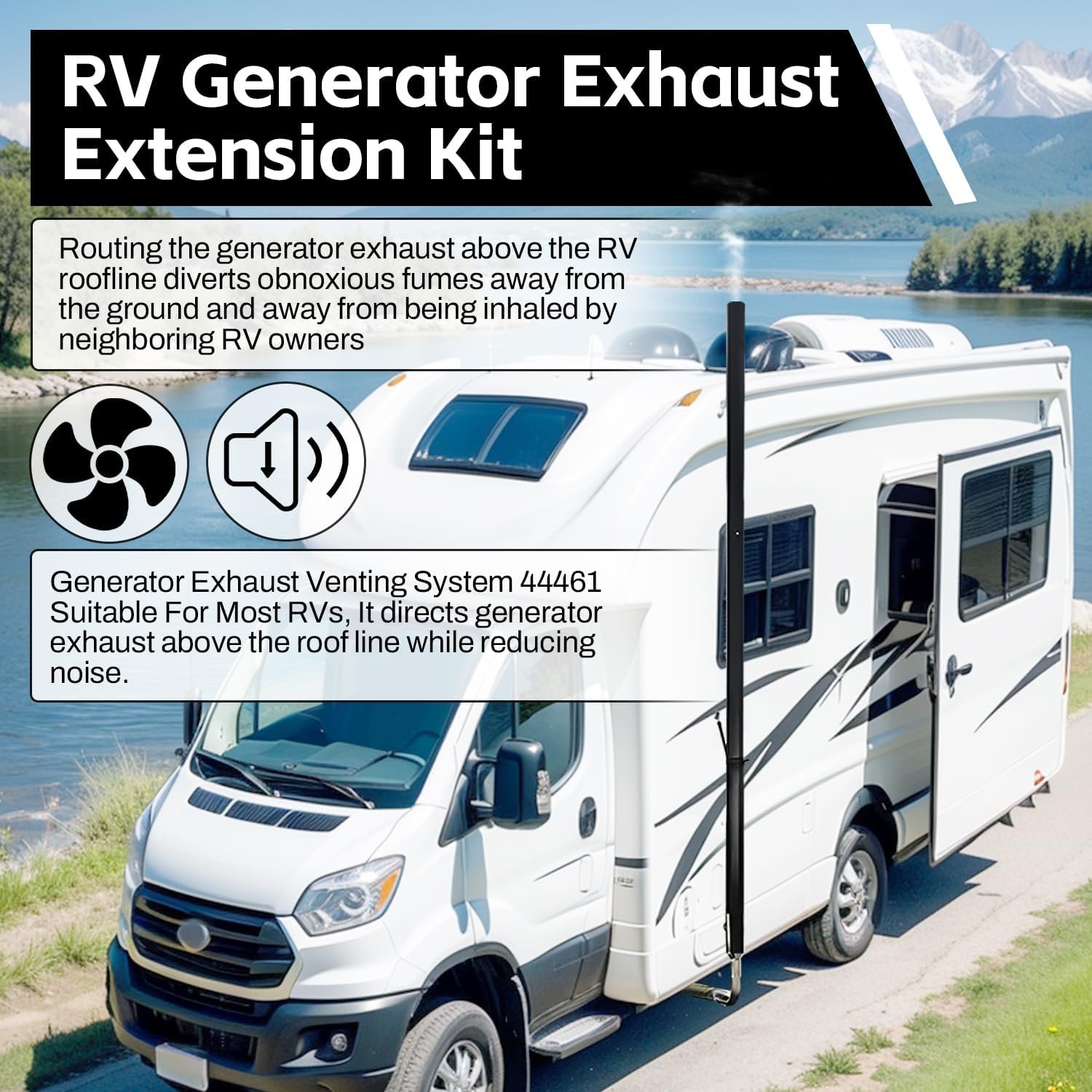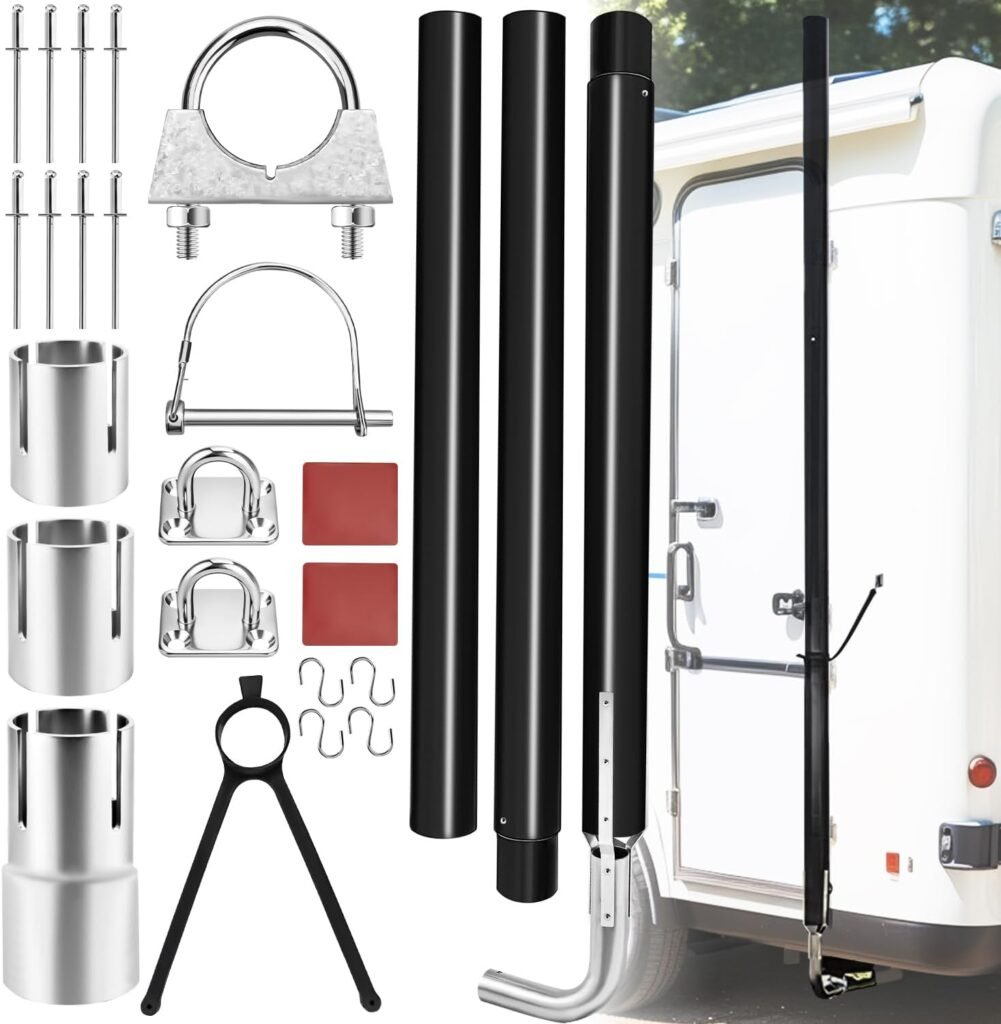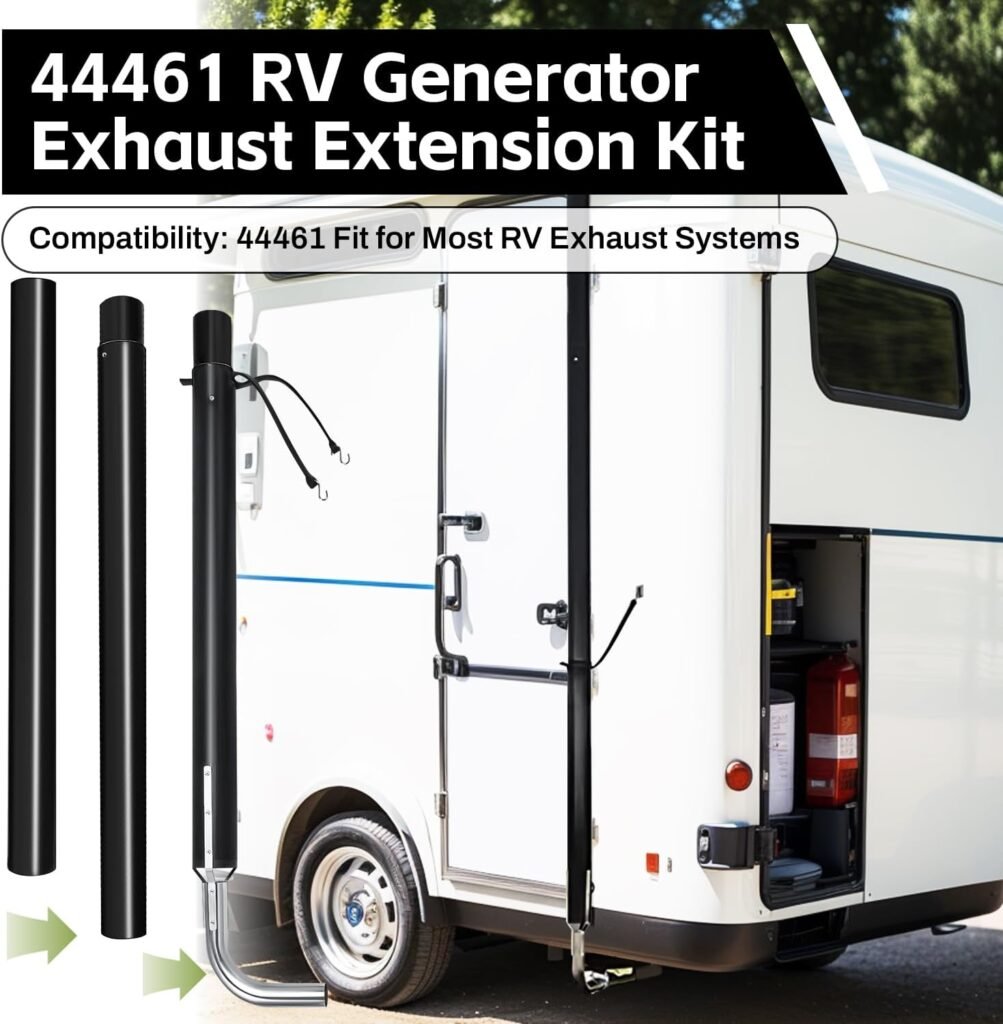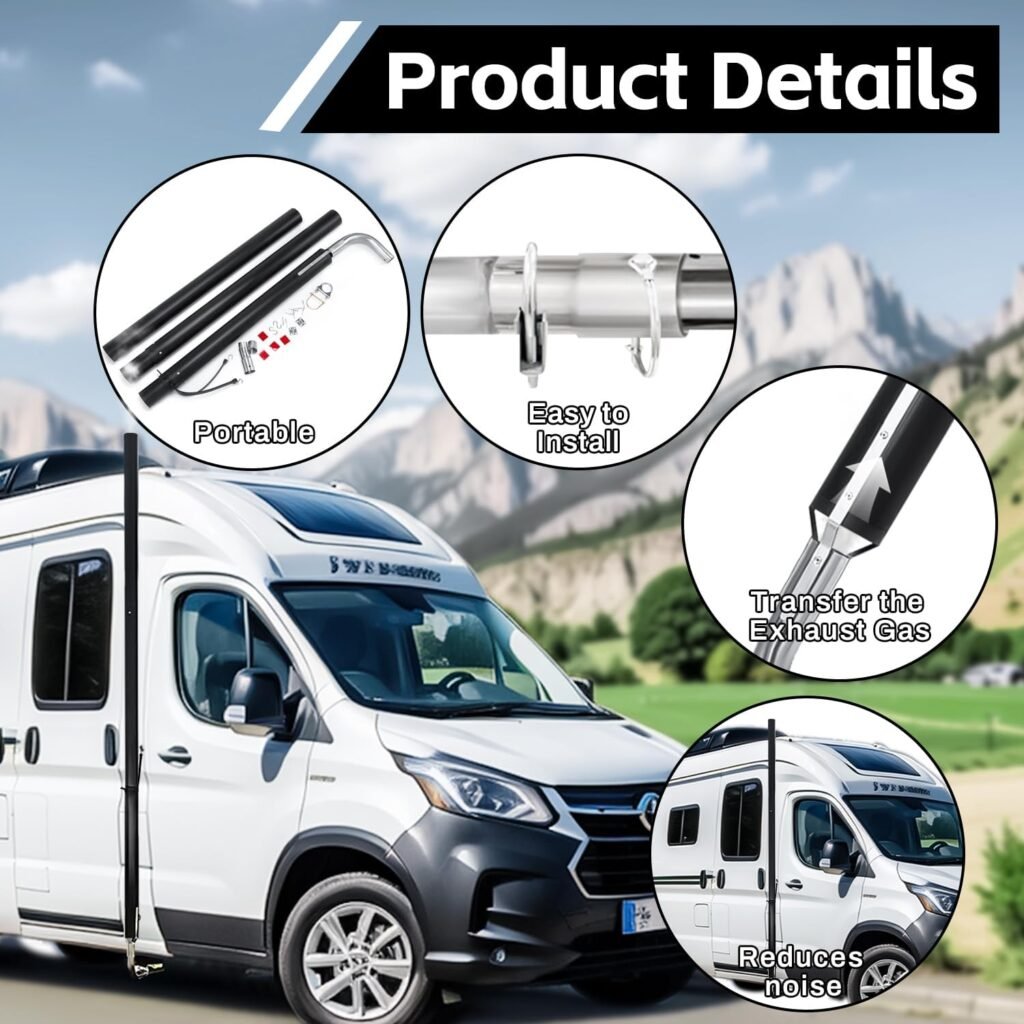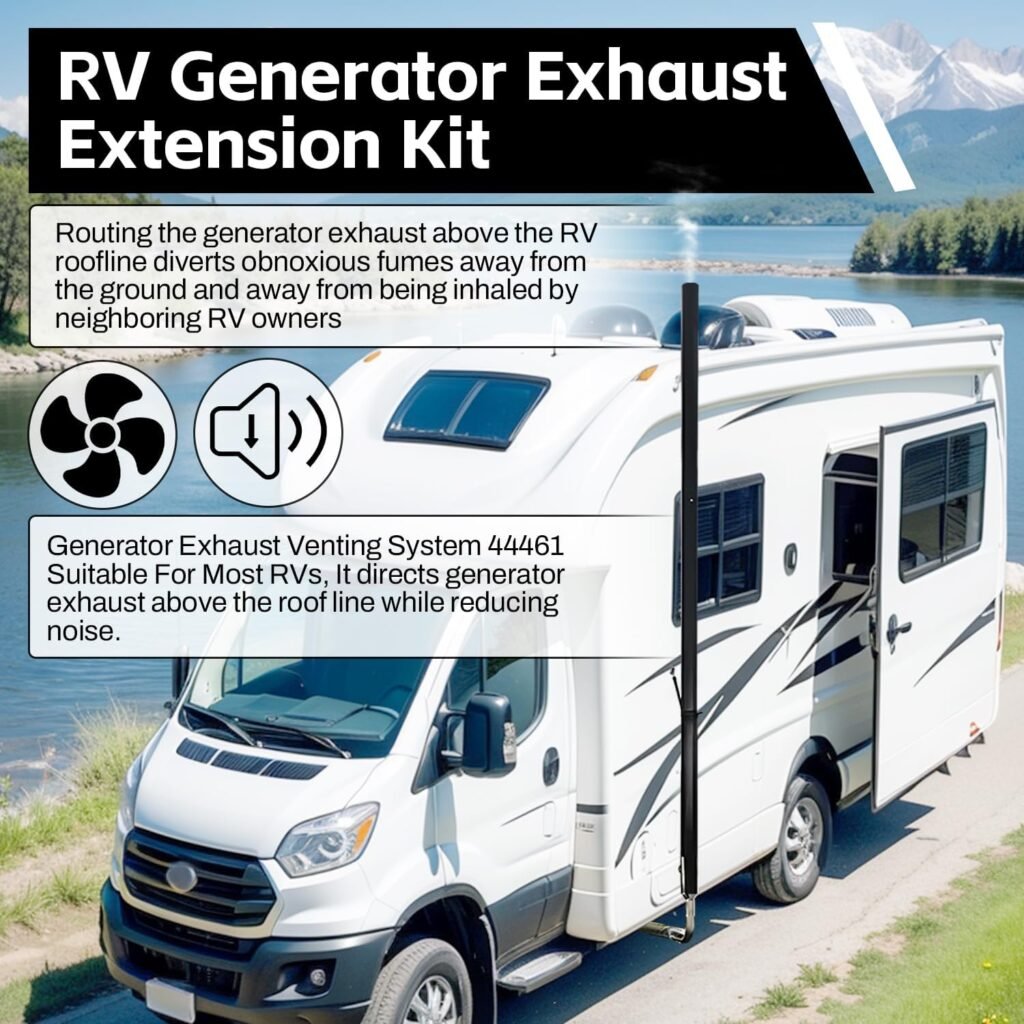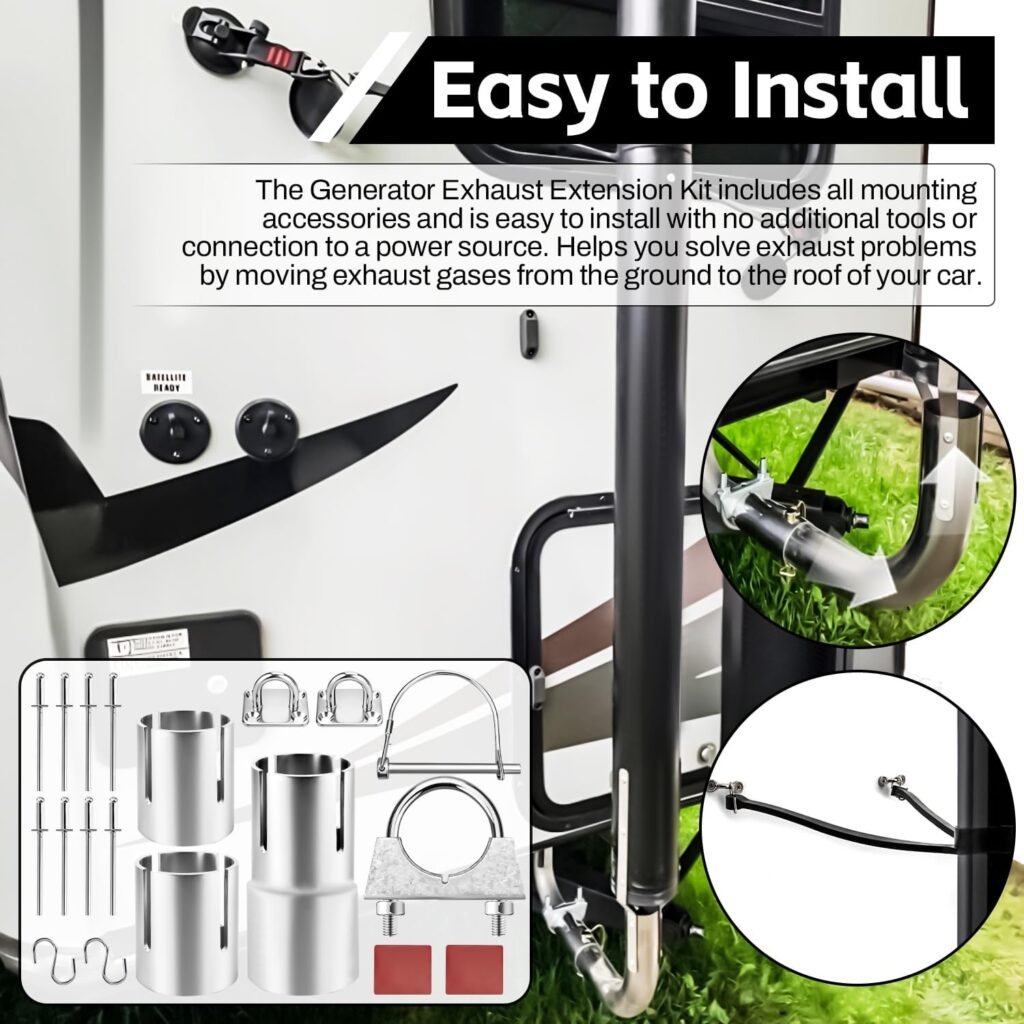44461 RV Generator Exhaust Extension Kit review
44461 RV Generator Exhaust Extension Kit review
Are you ready to stop generator fumes from creeping into your living area and make your campsite quieter?
Product Overview
You’re looking at the 44461 RV Generator Exhaust Extension Kit, RV Generator Exhaust Venting System 44461 for Most RV Exhaust Systems to help keep fumes and noise farther away from your RV. This kit is designed to extend the exhaust outlet of your RV generator so exhaust gases are mixed with fresh air and directed away from your vehicle and living spaces. You’ll find it promises broad compatibility, durable PVC construction, easier installation, and noise reduction features.
What this product includes
You’ll receive the extension kit body plus three adapters sized 1.5 inch, 1.4 inch, and 1.25 inch to fit a variety of generator outlets. The adapters help you connect the extension to common exhaust diameters found on many popular generator brands. There are also design elements intended to reduce noise and redirect fumes away from doors, vents, and outdoor living areas.
Who this kit is for
If you own an RV and use an onboard or portable generator, this kit is meant for you. It’s especially helpful when you frequently camp in close quarters, sleep near the generator, or use rooftop or side-mounted generator installations where exhaust can enter your living area. The kit targets owners of Generac, Cummins, Honda, Yamaha, and many other RV generator brands.
Key Features and Benefits
You’ll appreciate several practical benefits from the 44461 kit — it’s not just a piece of pipe. The product is tailored to address common RV generator nuisances like odors, heat, and noise, and it offers multiple adapters so you can fit different generator exhaust sizes.
Compatibility
Compatibility is a major point here, and the kit supports most RV exhaust systems. Because it includes three adapter sizes (1.5″, 1.4″, 1.25″), you can match many generator outlet diameters without fabricating custom parts. You should still check your generator’s exhaust diameter before you buy to be certain the included adapters will fit.
Materials and durability
This extension is made of high-quality PVC, which means it resists oxidation and abrasion better than thinner plastics. That helps it withstand sun, rain, and road vibration over time. While PVC won’t match stainless steel for extreme longevity around direct exhaust heat, the kit is designed to put distance between hot exhaust gases and the PVC body to reduce direct thermal stress.
Functionality — exhaust redirection and mixing
By lengthening the exhaust outlet, you’ll encourage the generator’s hot fumes to mix with ambient air before they reach your RV or campsite. This mixing reduces the concentrated smell of exhaust and directs fumes away from living areas. In practice, that can dramatically improve the comfort of your campsite and reduce airborne soot accumulation near vents and windows.
Noise reduction
The kit claims to include built-in muffler or silencer elements, which are intended to lower perceived noise levels. While it won’t turn a generator into a whisper-quiet appliance, you should notice less high-frequency noise and a slightly more muffled overall tone. This can be especially helpful during late-night operation when neighbors and family members are nearby.
Easy installation
You’ll find installation is straightforward and doesn’t usually require specialized tools. The goal is to give you a quick, secure way to extend your generator exhaust without welding or complex fittings. Most users can attach the adapter to the generator outlet and secure the extension with clamps or screws.
Specification Table
You’ll find a quick summary here to make it easier to compare the most important points at a glance.
| Item | Detail |
|---|---|
| Product Name | 44461 RV Generator Exhaust Extension Kit, RV Generator Exhaust Venting System 44461 for Most RV Exhaust Systems |
| Compatibility | Generac, Cummins, Honda, Yamaha, and many other RV generators; fits most RV exhaust systems |
| Adapters Included | 1.5″ (38 mm), 1.4″ (approx 35.6 mm), 1.25″ (31.75 mm) |
| Material | High-quality PVC (oxidation and abrasion resistant) |
| Main Functions | Exhaust redirection, mixing with fresh air, noise reduction |
| Installation | Designed for easy, tool-light installation |
| Noise Control | Built-in muffler/silencer design elements claimed |
| Weather Resistance | PVC resists outdoor elements; designed for long-lasting performance |
| Typical Use | RV camping, outdoor events, generator operation near living areas |
Installation Guide (Step-by-step)
You’ll get the best results if you follow a careful installation process. Below are general steps you can adapt to your generator and RV layout. Each step lists a couple sentences of explanation to keep things simple.
Preparation and safety
Before you start, make sure the generator is off and completely cooled. Always wear gloves and safety glasses when working on exhaust systems, and ensure you have a fire extinguisher nearby just in case.
Check exhaust diameter and adapter fit
Measure your generator’s exhaust outlet with calipers or a tape measure, then select the adapter that fits snugly. A secure fit prevents exhaust leakage and reduces vibration.
Attach adapter to generator outlet
Slide the chosen adapter onto the generator’s exhaust outlet and secure it with the provided clamps or hardware. If no clamps are provided, use a stainless-steel exhaust clamp of the appropriate diameter.
Connect extension body to the adapter
Attach the main extension piece to the adapter, aligning it so exhaust is directed away from doors, windows, and air intakes. Ensure the connection is tight and use silicone gasket tape if needed to seal the seam.
Secure and angle the extension
Mount the extension so it points away from living areas and doesn’t rub against flexible components or the RV body. Use reinforcement straps or brackets for long runs to prevent sagging and vibration fatigue.
Test for leaks and operation
Start the generator and watch for exhaust leaks or vibrations. If you detect any leaks, tighten clamps or apply high-temp sealant where needed. Observe how the sound changes and ensure fumes are redirected away from the RV.
Noise and Comfort: What to Expect
You’ll notice a reduction in sharp, high-frequency noise and a subtle drop in overall decibels with the muffler design. It’s realistic to expect a quieter experience rather than silence — the kit reduces noise so your sleeping family and nearby campers will hear less of the generator’s presence.
How the kit alters sound
By lengthening and partially baffling the exhaust path, the extension shapes the sound waves and reduces direct propagation of noise. This makes the generator sound more muted and far away, especially if you point the outlet toward the rear or away from your campsite.
Nighttime operation considerations
When you need to run your generator at night, this kit can help maintain a better relationship with neighbors. You’ll still want to pair the kit with responsible generator usage (e.g., running at lower loads when possible) to minimize disturbance.
Durability and Weather Resistance
You’ll be relying on this kit to perform outdoors, so material choice matters. PVC is chosen for its UV and corrosion resistance and typically stands up well to the elements when installed correctly.
Expected lifespan and maintenance
With proper installation and occasional inspection, you can expect the kit to last through multiple camping seasons. Keep an eye out for UV crazing, cracks, or fatigue at connection points and replace clamps or straps as they show wear.
Protecting the PVC from heat
Although the kit places distance between hot gases and the PVC, you should avoid letting the extension come into direct contact with extremely hot surfaces. Insulation wraps or heat shields can be added in high-heat installations.
Pros and Cons
You’ll want to weigh the strengths and limitations of this kit before purchasing. Below is an honest overview to help you decide.
Pros
- Broad compatibility across many common generator brands.
- Three adapter sizes included for flexible fitment.
- PVC construction resists oxidation and abrasion.
- Designed to reduce both fumes near the RV and high-frequency sound.
- Easy, mostly tool-light installation.
- Cost-effective alternative to custom metal exhaust work.
Cons
- PVC isn’t as heat-resistant as stainless steel; it relies on distance from heat for longevity.
- Noise reduction is moderate — it won’t replace a professional muffler system for extreme noise issues.
- The included adapters may not fit some non-standard or very large-diameter exhausts.
- Long-term exposure to UV and rough conditions requires periodic inspection and potential replacement.
Comparison to Alternatives
You’ll likely consider other options like custom stainless steel extensions, universal flexible metal exhaust hoses, or brand-specific exhaust kits. Here’s how this product measures up.
PVC extension kit vs. stainless steel custom work
If you want the ultimate heat resistance and longevity, stainless steel wins. However, custom metal work requires fabrication or welding and costs more. The 44461 kit gives you a cheaper, quicker solution with good performance for typical RV use.
PVC extension kit vs. flexible metal hose
A flexible metal hose offers flexibility and higher temperature tolerance, but it can be noisy and prone to corrosion depending on the metal quality. This PVC kit is quieter and more resistant to oxidation, though less tolerant of direct high-temperature exposure.
PVC extension kit vs. brand-specific kits
Brand-specific kits may fit perfectly without adapters and sometimes use higher-grade materials. The 44461 kit trades that brand-specific fit for broad compatibility and a lower cost. If you want simplicity and value, this kit is a strong choice.
Maintenance and Troubleshooting
You’ll keep performance high by doing periodic checks. These practical maintenance tips will help you spot problems early and extend the kit’s life.
Routine checks
Inspect clamps, adapters, and the extension body every few months. Look for cracks, loose fittings, or discoloration that might indicate heat stress or UV damage.
Cleaning
Wipe the exterior with mild soap and water to remove soot and grime. If you find internal soot buildup, you can remove the extension and clean inside with a brush and water after the part has cooled.
Dealing with leaks
If you smell exhaust or see black soot at joints, tighten clamps and add high-temperature exhaust sealant or gasket tape as needed. Recheck after a short run to confirm the seal holds at operating temperature.
When to replace
Replace the extension if you see cracks, deformities, or persistent leaks that don’t respond to tightening. Also replace clamps that show corrosion or loss of tension.
Safety Considerations
You’ll be handling an exhaust system that deals with hot gases and potentially toxic fumes, so safety is critical. Follow these safety notes every time you work on the system.
Carbon monoxide awareness
Never assume that redirected exhaust eliminates carbon monoxide risk entirely. Always use a carbon monoxide detector in your RV and avoid running generators in enclosed areas.
Heat and fire risk
Keep the extension away from combustible materials and secure it so it can’t contact flammable items. Verify that the path of the exhaust doesn’t point at awnings, fabric, or nearby trees.
Vent placement and legal/regulatory concerns
Make sure redirected exhaust isn’t violating campground rules or local codes. Point the exhaust in a direction that minimizes impact on neighbors and public spaces.
Buying Tips and Fitment Checklist
Before you purchase, use this checklist to help ensure you get the right solution and a successful installation.
- Measure your generator’s exhaust diameter accurately.
- Confirm the physical routing you want for the extension and that it won’t interfere with other RV systems.
- Check if your exhaust outlet is unusually shaped or offset; some generators need an intermediate adapter.
- Inspect the product description to confirm material and adapter sizes (1.5″, 1.4″, 1.25″ included).
- Consider adding clamps, stainless hardware, or heat wrap if you expect high-temperature runs.
Real-world Use Cases
You’ll find this kit helpful in many real-world scenarios. Here are a few examples to help you imagine the difference it can make.
Family camping near generator
If you camp with family and run the generator for air conditioning or refrigeration, this kit will help reduce fumes and noise that otherwise intrude into the living space. You’ll sleep better and have fewer window and vent smells.
Tailgating and outdoor events
When you use a generator at a tailgate or event, the kit helps keep exhaust directed away from guests and food areas. Your setup will feel cleaner and more comfortable for everyone nearby.
RV parked at home
If you operate your RV generator at home, the kit reduces exhaust near your RV and property, improving air quality around lawn areas and decks. You’ll also appreciate the quieter operation.
Frequently Asked Questions (FAQ)
You’ll likely have some common questions; here are answers to help you decide and use the kit safely.
Will this kit fit my generator?
The kit includes adapters sized 1.5″, 1.4″, and 1.25″ to match many engines. Measure your exhaust outlet to be sure. If your outlet is outside those sizes, you may need an additional reducer or custom adapter.
Can PVC handle generator heat?
The PVC body is positioned to avoid direct exposure to the hottest gases and is designed to resist oxidation and abrasion. You should still avoid placing the PVC directly against exhaust manifold surfaces or extremely hot metal, and consider heat shields for high-heat setups.
How much noise reduction should I expect?
Expect a moderate reduction, especially in higher-frequency noise. It won’t eliminate sound, but it will make the generator sound more distant and muffled.
Will the kit prevent all fumes from entering the RV?
No kit guarantees complete elimination of fumes, but this extension will greatly reduce direct exhaust intrusion by mixing and redirecting gases away from vents and doors. You should also maintain window and vent seals and use interior detectors as a safety precaution.
Is extra hardware required?
Most installations use clamps and straps you might already have, but you may want stainless-steel clamps and extra brackets for long or exposed runs. If your outlet size differs, additional adapters could be required.
Final Verdict
You’ll get a cost-effective and practical solution with the 44461 RV Generator Exhaust Extension Kit, RV Generator Exhaust Venting System 44461 for Most RV Exhaust Systems if you want to reduce fumes and noise without major custom work. It’s a strong choice for many RV owners because of its compatibility, ease of installation, and PVC durability. While it isn’t a perfect replacement for heavy-duty metal exhaust systems, it provides a meaningful improvement in comfort and is simple to fit and maintain.
Who should buy it
If you want an affordable, fast way to divert generator exhaust away from your RV and reduce noise and fumes during trips, this kit suits your needs. It’s particularly well-suited for camping, tailgating, and occasional use where a full metal fabrication isn’t practical.
Final tips before you install
Measure twice before you buy, secure all connections, and monitor the system after the first few hours of operation. Keep safety front of mind — use CO detectors and make sure the exhaust outlet points away from people and living areas.
If you want, you can tell me your generator make and model and the exhaust diameter, and I’ll help you confirm whether the included adapters should fit or if you need additional parts.
Disclosure: As an Amazon Associate, I earn from qualifying purchases.
